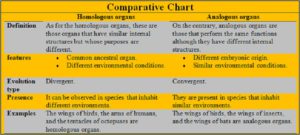Difference Between Homologous And Analogous Organs With Examples..
We explain that what is the difference between Analogous and Homologous Organs? In addition: Characteristics of Analogous and Homologous Organs with comparison chart to easily understand.
According to anatomical tests that are based on the comparison of the anatomy of different species in their structure and function, three types of organs have been found that defend the theory of evolution: homologous, analogous and vestigial organs. The difference between the first two is that homologues have similar structures and are adapted to different functions, while analogs have different structures but fulfill the same function.
Starting in the 1920s, homology began to be considered from a genetic perspective. In 1920 Alexander Weinstein coined the term homologous genes to refer to genes from different species with similar phenotypic expressions. In 1934 Alan Boyden claimed genetics as a tool for the recognition of homologies, which he considered, for the first time, as a “genetic phenomenon”.
Richard Owen was the first to make this difference terminologically explicit: homologous is “the same organ in different animals under all their varieties in form and function”; “analog is a part or organ in an animal that has the same function as another part or organ in a different animal . ”
What Are Homologous Organs?
Homologous organs are those that are similar in their internal structure , but that fulfill different functions depending on the species.
Homology normally occurs in bodies because they come from a common ancestral organ.
The functions performed by homologous organs can become totally different because the species have adapted to the characteristics of the environment where they develop.
The development of homologous organs happens thanks to divergent evolution , where two related species change a common ancestral structure during their evolution in order to survive by performing different functions.
For this reason it is said that organs are homologous when they have the same evolutionary origin , that is, a common ancestor, although they have developed fulfilling functions with different purposes.
Examples Of Homologous Organs
The forelimbs of vertebrates, such as the arms, the wings of birds, the arms of a man and the fins of a dolphin are homologous organs because they come from the same common ancestor, while fulfilling totally different functions. They come from a common ancestor but, due to divergent evolution, they adapted to the environment.
What Are Analogous Organs?
Analogous organs are those that are morphologically similar or carry out similar functions despite having a different genetic origin. Analogous organs have a different structure but have a similar shape and function . They occur is evolutionarily separate species, but that have adapted to the same environment. This is known as convergent evolution. An example is the wings of a fly and the wings of a bird. Both fulfill the function of flying but they are not similar.
Examples Of Analogous Organs

The wings of a fly and the wings of a pigeon are analogous organs.
Differences Between Homologous And Analogous Organs
- Homologous organs are those organs that are similar in their internal structure but perform different functions in organisms of different species.
- Analogous organs are those that present different structures but fulfill the same function in organisms of different species.
- Homologous organs come from divergent evolution.
- Analogous organs come from convergent evolution.
- Homologous organs are found in species that inhabit different environments.
- Analogous organs are found in species that inhabit a similar environment.
Through comparative anatomy, homologous and analogous organs can be found and differentiated in different organisms by contrasting them.
Comparative Chart
| Homologous organs | Analogous organs | |
|---|---|---|
| Definition | As for the homologous organs, these are those organs that have similar internal structures but whose purposes are different. | On the contrary, analogous organs are those that perform the same functions although they have different internal structures. |
| features |
|
|
| Evolution type | Divergent. | Convergent. |
| Presence | It can be observed in species that inhabit different environments. | They are present in species that inhabit similar environments. |
| Examples | The wings of birds, the arms of humans, and the tentacles of octopuses are homologous organs. | The wings of birds, the wings of insects, and the wings of bats are analogous organs. |





